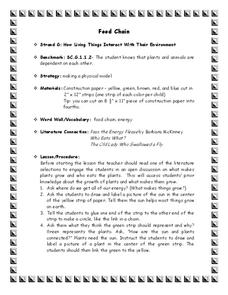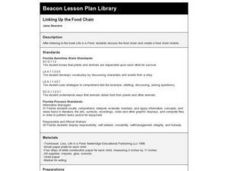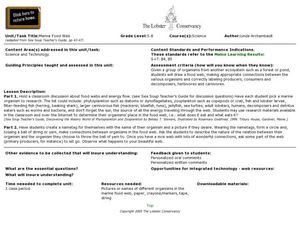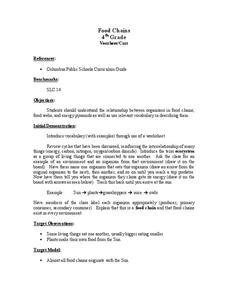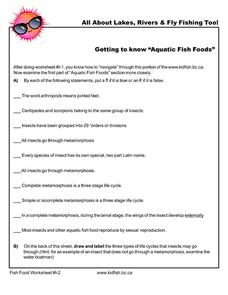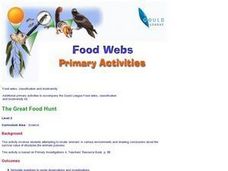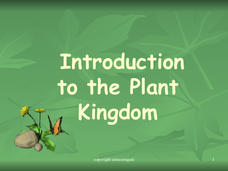Curated OER
Looking at Food Chains
In this Looking at Food Chains activity, students read about a food chain under the sea and underline important information. Next, students fill in a graphic organizer about food chains based on the information they just read.
Curated OER
Food Chains
Learners take a look at the relationship between organisms in food chains, food webs, and energy pyramids. After an opening demonstration by the teacher, pupils are split up into groups. Each one is assigned an environment such as:...
Curated OER
Where are Koalas on the Food Chain?
Take a field trip to observe Koalas, absolutely! Budding scientists become familiar with the Koala's position in the food chain. They answer questions based on what they see and draw a food chain explaining the Koalas position. Tip: A...
Curated OER
Food Chain
Students discuss what makes plants grow and who eats the plants. They are asked where do we get all of our energy? Students are asked to draw and label a picture of the sun in the center of the yellow strip of paper. They are explained...
Curated OER
Linking Up the Food Chain
Students to the book, Life in a Pond, then discuss the food chain and create a food chain mobile. On one strip of paper students draw and label a pond plant, on another a tadpole, on another a fish and on the last a person.
Curated OER
Food Chain
Third graders role-play various organisms from a food chain to illustrate how a food chain works. In relay style, 3rd graders fill their cups (stomachs) and, in turn, fill a larger organism's cup (stomach) to visualize the importance of...
Curated OER
Food Chain
Third graders explore why food chains are important. In this food chain lesson, 3rd graders break into small groups to represent parts of the food chain. Different amounts of food are given to each group and any spilled food will be...
Curated OER
Marine Food Web
Students investigate the effects of the food chain on all animals by creating a food web. In this seafood activity, students discuss energy flow and research a specific marine organism of their choice. Students create a food...
Curated OER
Getting Food
Students explore seashore ecosystems. In this marine animal biology activity, students sort photographs of various sea creatures according to their eating habits and discuss each animal's identifiable traits. Students draw...
Curated OER
Healthy Snacks. Healthy Packaging
Fourth graders research how to select the most cost-effective snacks. In this consumer practices lesson, 4th graders compare packaging labels and come to conclusions on how cost effective the product is. Students discuss their findings.
Curated OER
Everybody Needs a Little Sunshine
Three activities introduce upper elementary ecologists to photosynthesis and food webs. In the first, an experiment is set up to determine how plants respond to different types of light. In the second, they connect organism cards with...
Curated OER
Food Chains
Fourth graders investigate food chains. They review cycles and discuss ecosystems. They select an environment and create a food chain in small groups. They write their food chain and label it for the class to evaluate. They create...
Curated OER
Food Web Relationships
In this food web worksheet, students create a food web matrix and answer short answer questions about the food chain according to the matrix. Students complete 7 short answer questions.
Curated OER
Biological Molecules
Ninth graders examine the structure and function of biomolecules. In this food molecule lesson plan, 9th graders will examine various types of biomolecules such as carbohydrates, lipids, proteins, and nucleic acids. They will...
Curated OER
Getting to Know "Aquatic Fish Foods"
In this fish worksheet, students access a website to learn more about the common insects eaten by fish. Then students draw and label three types of insect life cycles. This worksheet has 10 true or false questions and 3 drawings.
Curated OER
Bacteria
Learners study the advantages and disadvantages of bacteria. In this bacteria lesson students draw and label the different types of bacteria.
Curated OER
Wetlands - Food Web Relationships
In this food web relationships worksheet, students click on the links to learn about the food web relationships in the wetlands and answer short answer questions about it. Students complete 8 questions total.
Curated OER
The Food Chain
In this food chain worksheet, students see 4 blank boxes over 2 blank lines. Each box is labeled with a new vocabulary word pertaining to the food chain. Students write a definition of each word and draw an example.
Curated OER
Where Does Food Go?
Students understand how their food moves through the digestive system. In this digestion lesson, students measure the length of the digestive system from a projection of it. Students draw their own pictures of the digestive system.
Curated OER
Texas Ecoregions Summary Sheet
In this ecoregions of Texas worksheet, learners complete a summary of a particular ecoregion in Texas. They find the producers and consumers of the region, they draw a food chain, the draw a food web, and they complete an energy pyramid...
Curated OER
Carrot Sticks or French Fries?
Students investigate the influence of fast food brand names on food choices and analyze the factors that contribute to branding preferences. They write an opinion essay on the corporate responsibility to influence food choices.
Curated OER
Protists: animallike Protists
Students are taught that Malaria and African Sleeping sickness are caused by protists. They discuss how animal-like protists harm other living things. Students discuss and listen to the major phyla of animallike protists. They draw...
Curated OER
The Great Food Hunt
Students locate 'animals' in various environments and draw conclusions about the survival value of structures the animals possess. They create model macaroni animals and hide them and other teams of students find them and evaluate the...
Biology Junction
Introduction to the Plant Kingdom
Plants provide humans with food, shelter, and medications. Scholars gain a better appreciation for plants after learning their functions, divisions, and early ancestors. Each sub-topic includes slides highlighting vocabulary and...



